陈述句变成一般疑问句电子教案
- 格式:doc
- 大小:64.00 KB
- 文档页数:20
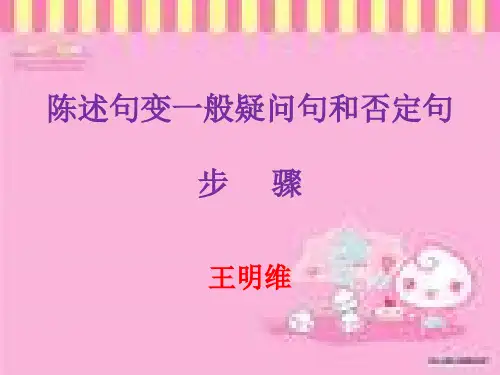
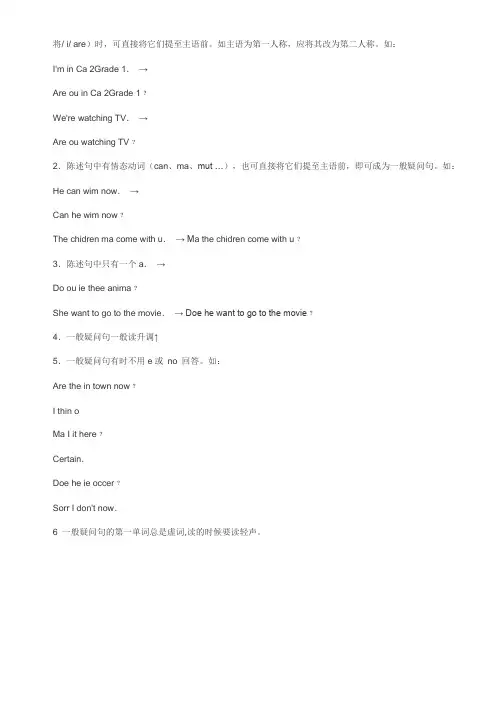
将/ i/ are)时,可直接将它们提至主语前。
如主语为第一人称,应将其改为第二人称。
如:
I'm in Ca 2Grade 1.→
Are ou in Ca 2Grade 1﹖
We're watching TV.→
Are ou watching TV﹖
2.陈述句中有情态动词(can、ma、mut …),也可直接将它们提至主语前,即可成为一般疑问句。
如:He can wim now.→
Can he wim now﹖
The chidren ma come with u.→ M a the chidren come with u﹖
3.陈述句中只有一个a.→
Do ou ie thee anima﹖
She want to go to the movie.→ Doe he want to go to the movie﹖
4.一般疑问句一般读升调↑
5.一般疑问句有时不用e或no 回答。
如:
Are the in town now﹖
I thin o
Ma I it here﹖
Certain.
Doe he ie occer﹖
Sorr I don't now.
6 一般疑问句的第一单词总是虚词,读的时候要读轻声。
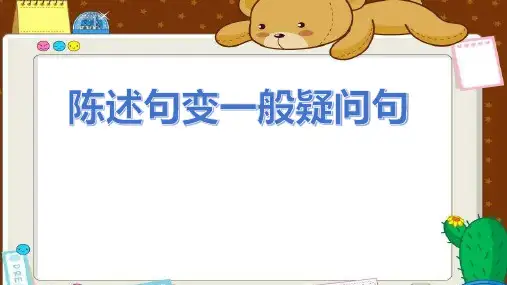

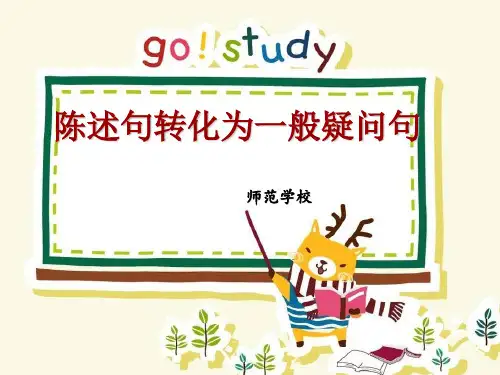
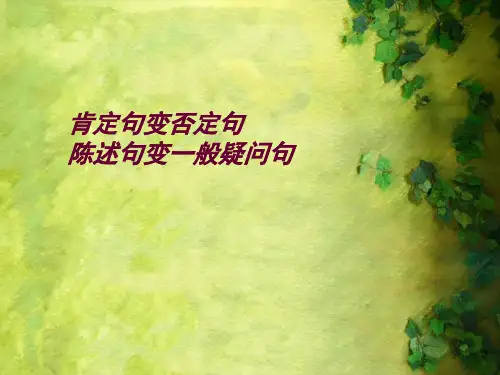
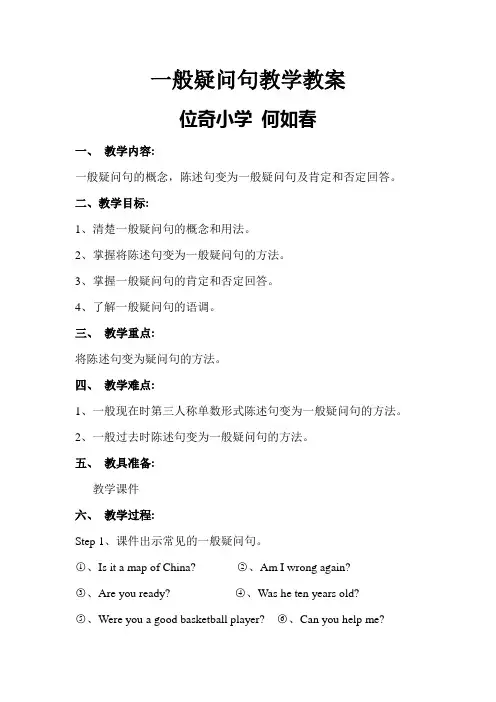
一般疑问句教学教案位奇小学何如春一、教学内容:一般疑问句的概念,陈述句变为一般疑问句及肯定和否定回答。
二、教学目标:1、清楚一般疑问句的概念和用法。
2、掌握将陈述句变为一般疑问句的方法。
3、掌握一般疑问句的肯定和否定回答。
4、了解一般疑问句的语调。
三、教学重点:将陈述句变为疑问句的方法。
四、教学难点:1、一般现在时第三人称单数形式陈述句变为一般疑问句的方法。
2、一般过去时陈述句变为一般疑问句的方法。
五、教具准备:教学课件六、教学过程:Step 1、课件出示常见的一般疑问句。
○1、Is it a map of China? ○2、Am I wrong again?○3、Are you ready? ○4、Was he ten years old?○5、Were you a good basketball player? ○6、Can you help me?○7、Would you like coffee? ○8、Do you live in China?○9、Does she like to play basketball?○10、Did Danny go to school yesterday?○11、Will you go shopping tomorrow?让学生同桌互都,并讨论这些句子的特点,最终能从中找到规律,知道它们都是一般疑问句。
(设计意图:让学生从平常的句子中初步感受到一般疑问句的特点和读法,为开展后面的内容做热身。
)Step 2、出示问题,小组讨论。
问题:什么是一般疑问句?方法:在教师的引导下小组讨论。
通过上面句子的出示,学生能大概说出一般疑问句的特点,并能在老师的指引下最终得出一般疑问句的概念。
Step 3、教学怎样将一个陈述句变为一般疑问句。
(一)、将含有be动词的陈述句变为一般疑问句。
1、复习be动词(am\is\are\was\were)及它的用法。
2、出示例句试着让学生来变,并作出回答。


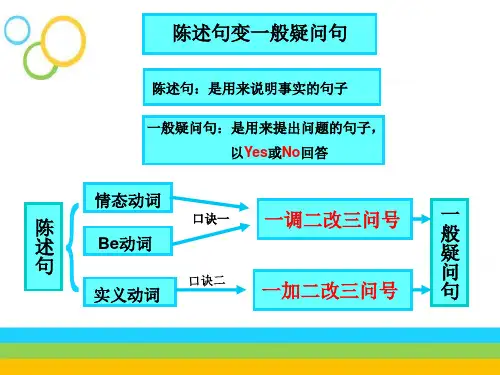
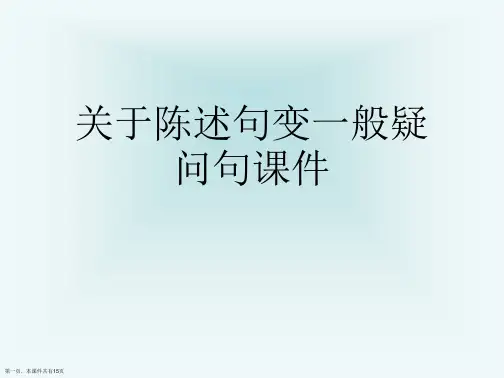
《陈述句变一般疑问句》教学设计难点:掌握变一般疑问句的两个口诀:一调二改三问号、一加二改三问号。
★教学方法直观教学和启发式教学★教学手段利用多媒体电脑进行教学,制作ppt课件来展示整个教学的内容和过程,形象生动,给学生以良好的视觉效果★教学过程教学环节教师活动设计意图课程导入大家好,欢迎进入微课,今天我讲的内容是:小学英语冀教版五年级下册Unit4 Did you have a nice trip?中的语法内容——陈述句变一般疑问句。
明确微课主题,让观看者一目了然。
讲授新课Step1 了解陈述句与一般疑问句的概念,了解两个口诀理清概念,指出陈述句变一般疑问句的口诀内容,让观看者明确微课重点。
Step2 理解口诀一:一调二改三问号细化口诀一“一调二改三问号”内容,让观看者更加理解含义。
Step3 通过例句,学习口诀一:一调二改三问号例句1 I can swim. (我会游泳。
)这个句子中含有情态动词can,变一般疑问句时要用到口诀一:一调二改三问号;第一步,调Can到句首,首字母大写,将剩下的句子成分写下来,Can I swim. 我会游泳吗?这句话理论上是正确的句子,但日常交流中我们很少这样问,而是问“你会游泳吗?”这就要涉及第二步:改人称,将句中第一人称I改成第二人称you,第三步:三问号将句末的句号改成“?”例句2 They are teachers. (他们是老师。
) 通过两个例句展示口诀一的变化过程,直观形象,生动具体,步骤清晰明确,让观看者进一步理解“一调二改三问号”。
这个句子中含有Be动词are,变一般疑问句时还是要用到口诀一:一调二改三问号;第一步,调Are到句首,首字母大写,将剩下的句子成分写下来,第二步:改人称,此步骤不用考虑,因为句中没有第一人称,第三步:三问号将句末的句号改成“?”所以变后的一般疑问句是:Are they teachers?Step4 理解口诀二:一加二改三问号细化口诀二“一加二改三问号”内容,观看者在理解口诀一的基础上更容易理解口诀二。
四年级英语寒假教案第七讲一般疑问句一、什么是一般疑问句:用Yes或No作答的疑问句叫一般疑问句。
1、以be动词、助动词或情态动词开头;例:Is your father a teacherDoes Mike like animalsCan Jenny speak French2、往往读升调;3、译成汉语,“吗”,例如上面三句可分别译为:你父亲是老师吗迈克喜欢动物吗詹妮会说法语吗二、如何将陈述句变成一般疑问句要将陈述句变成一般疑问句,可以遵循下列步骤:1.看句中有没有be动词(am、is、are、was、were)、助动词(do、does、did、have、had)或情态动词(can、must、will、may等),如果有,将其提到句首,句末打上问号即可。
例:It is a cat. → Is it a catTom's father can play football. → Can Tom's father play the piano2.如果句中没有be动词、助动词或情态动词,则根据谓语动词的形式借助do 的相应形式放在句首。
具体方法是:如果谓语动词是原形,则借do;如果谓语动词是一般现在时第三人称单数形式,则借does;如果谓语动词是过去式,则借did. 需要注意的是,借does或did 后,原句的谓语动词要变回原形。
例:They go to school at 7 o’clock. →Do they go to school at 7 o’clockBill gets up at 6:30 every day. →Does Bill get up at 6:30 every day三、陈述句变一般疑问句应注意的事项陈述句变成一般疑问句除了遵循上述规则以外,还应注意下列几点:1.如果陈述句中有第一/二人称,则变问句时要互换。
I/we ↔ you, my/our ↔ your例:I usually have lunch at school. →Do you usually have lunch at school My father is playing soccer. →Is your father playing soccer2.如果陈述句中有some, 则变问句时往往要变成any 。
陈述句变成一般疑问句陈述句变成一般疑问句:陈述句变为一般疑问句,首先看句中有没有系动词be或情态动词,如果有,把be或情态动词直接提到句首就可以了;如果没有,要用助动词do 或does 来帮助。
基本句式如下:Be + 主语 +宾语 + 其他 + ?情态动词 + 主语 + 谓语 + 宾语 + 其他 + ?Do(Does) + 主语 + 谓语 + 宾语 + 其他 + ?(1)如果句子中有be动词(也就是说有is,am,are,were,was等)或是情态动词的(如can, could,will,would等),把be动词或情态动词直接提前,剩下的照抄,然后末尾加上问号。
如:He is a student.(他是一个学生。
)一般疑问句就是:Is he a student?.(他是一个学生吗?)They can play football.(他们会踢足球。
)变成Can they play football?(他们会踢足球吗?)注意:如果主语是I或是we的,一般疑问句一般情况下要把人称改为you。
反之you要改成I,we,me或us。
如:I am a student. 一般疑问句就变成Are you a student?We can help you.(我们能帮你。
)变成 Can you help me?(你们能帮我吗?)(2)如果没有be动词和情态动词的,就要用助动词来提问,助动词有do,does,did。
而选择哪个助动词就要由陈述句中的动词时态或形式来决定了。
如:She speaks English very well.(她英语说得很好。
)一般疑问句变成 Does she speak English very well?(她英语说得很好吗?)We finished our homework yesterday.(我们昨天完成作业的。
)变为Did you finish your homework yesterday?(你们昨天完成作业的吗?)I go to school on foot.(我走路去上学。
)变为Do you go to school on foot?(你走路去上学吗?)选择好助动词后就可以把原句跟上去,要注意的是后面的动词要用原形了。
如例子中的speak,finish等。
另外,完成时态和have、has got(have got 是“有”的意思)中的have或has也是提前,即与第一种be动词情态动词的用法相同。
如:I have got a sister.(我有一个妹妹)改为:Have you got a sister?(你有一个妹妹吗?)完成时的例子:I have ever been to Beijing.(我曾经去过北京)Have you ever been to Beijing?(你曾经去过北京吗?)陈述句变为一般疑问句基本上应该就这样的吧。
这可都是我自己总结的哦。
因为自己是老师,所以也就是这么教学生的。
英语怎样做否定句,一般疑问句,对划线部分提问,有怎样的技巧,举几个例子一、否定句1.主语+be动词+表语结构变否定句,直接在be动词后面加个not就可以了。
Mr. White is a very good teacher.-->Mr. White is not a very good teacher.2.主语+动词+其他当此句为一般现在时,在动词之前加don't或doesn't(第三人称单数形式),并将动词变为原形就可以了He loves playing football with his friends.-->He doesn't love playing football with his friends.当此句为过去时,在动词之前加didn't,并且把动词变为原形Tom's sister graduated from high school last year.-->Tom's sister didn't graduate from high school last year.3.主语+情态动词+动词+其他在情态动词后面加not就可以了I can drive a car.-->I cannot drive a car.4.主语+have/has+动词过去分词+其他在have/has后面加not就可以了The students have done their homework.-->The students have not done their homework.二、一般疑问句1.主语+be动词+表语结构变一般疑问句,把be动词提前,句子就变成 be动词+主语+表语结构?Mr. White is a very good teacher.-->Is Mr. White a very good teacher?2.主语+动词+其他当句子为一般现在时,在句首加do或does,并且把动词变为原形,句子变成Do/Does+主语+动词原形+其他?He loves playing football with his friends.-->Does he love playing football with his friends?句子为一般过去时,在句首加did,句子变成 Did+主语+动词+其他?Tom's sister graduated from high school last year.-->Did Tom's sister graduate from high school last year?3.主语+情态动词+动词+其他将情态动词提前,句子变成情态动词+主语+动词原形+其他?I can drive a car.-->Can you drive a car?4.主语+have/has+动词过去分词+其他将have/has提前,句子变成have/has+主语+动词过去分词+其他The students have done their homework.-->Have the students done their homework?三、对划线部分提问先找出划线部分在句子中所占得成分,找到对应的疑问词,将疑问词写在句首,再将原句变成一般疑问句,却掉划线的部分,写在疑问词后面就可以了。
Tom bought a new computer from the store yesterday.若划线部分为Tom,Tom 是个人,且作主语,则疑问词应选Who,此句应该为 Who bought a new computer from the store yesterday?若划线部分为a new computer,划线部分为物,则疑问词为what,此句应为What did Tom buy from the store yesterday?若划线部分为from the store,则疑问词应为Where,表示地点,此句应为Where did Tom buy a new computer yesterday?若划线部分为yesterday,则疑问词为When,表示时间,此句应为 When did Tom buy a new computer from the store?英语怎样变句型一般疑问句否定句反问句肯定句画线提问1. 由连系am,is,are构成的句子:变一般疑问句时把am,i s,are提到句子的前面,句尾用问号即可。
变否定句时直接在a m,is,are后面加not即可。
例如:肯定句:He is a student.一般疑问句: Is he a student?否定句: He is not a student.反问句: He is a student, isn't he?He isn't a student, is he?画线提问: 对he提问: Who is a student?对 a student 提问: What is he? or What does he do?2. 由情态动词can, may, should等构成的句子: 变一般疑问句时把can,may,提到句子的前面,句尾用问号即可.变否定句时直接在can,may,后面加not即可. 例如:肯定句: She can swim.一般疑问句: Can she swim?否定句: She can not swim.反问句: She can swim, can't she?She can not swim, can she?画线提问: 对she提问: Who can swim?对swim提问: What can she do?3. 由行为动词构成的句子: 需要加助词do或does. 变一般疑问句时把do/does放在句子前面. 例如:肯定句: They play football after school.一般疑问句: Do they play football after school?否定句: They don't (do not) play football after school.反问句: They play football after school, don't they?They don't play football after school, do they?画线提问: 对they提问: Who play football after school?对play football提问: What do they do after school?对after school提问: When do they play football?小学英语语法提高/一般疑问句和特殊疑问句疑问句可再分为一般疑问(General question)和特殊疑问(Special question)两种。
1.一般疑问:用be或助动词或情态动词置于句首,并以“Yes,…”,或“No,…”或相当于yes / no回答的问句称为一般疑问句.2. 含系动词be的一般疑问句的构成具体地说,am 只能跟在第一人称的单数 I 后面,are 搭配 you, 不管是单数还是复数,is 跟在第三人称单数 he, she 后面,be 动词的基本意思:是如:I'm in Class 2, Grade 1. →Are you in Class 2, Grade 1? 你是在一年级二班吗?(如遇第一人称,最好将其置换成第二人称)It's a map of China. →Is it a map of China? 这是一幅中国地图吗?be 或 have(有)置于句首来表达疑问,例:Am I wrong again? (我又错了?)Yes, you are (wrong again). (是的,你又错了。